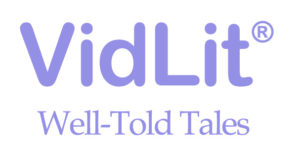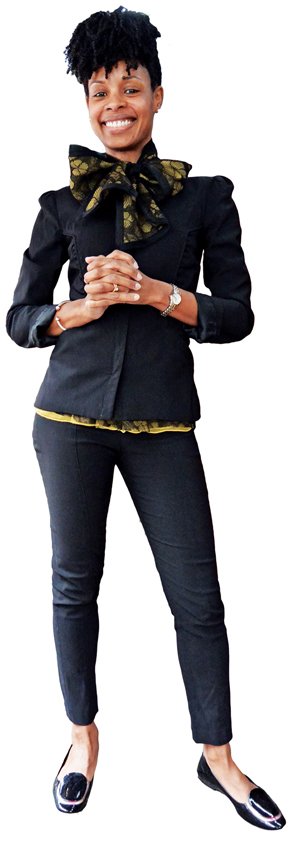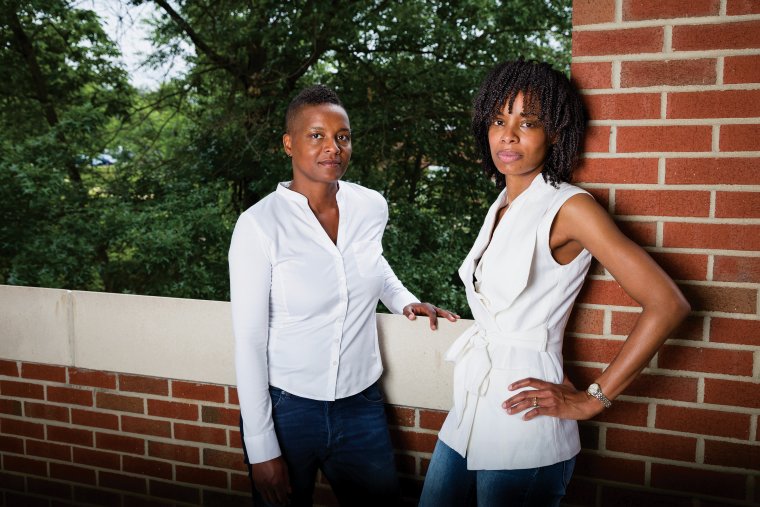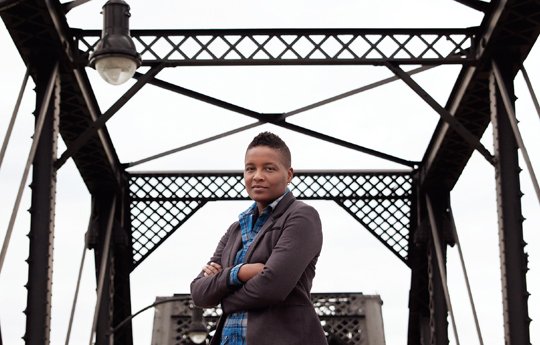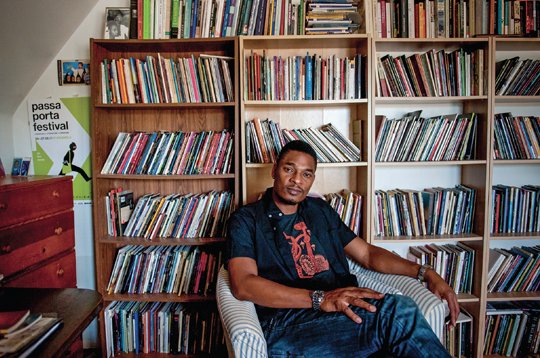The poets whose work I return to again and again answer a call that compels them, meaning their poems cannot not exist. I can’t escape them, even though what I want from poetry is lightless, weightlessness, to be untethered. The poems—for the writer and for me, the reader—create the feeling, however temporarily, that I am free.
Nicole Sealey is one such poet. Born in St. Thomas and raised in Apopka, Florida, she is the author of Ordinary Beast, published this month by Ecco, and The Animal After Whom Other Animals Are Named, winner of the 2015 Drinking Gourd Chapbook Poetry Prize. She is also the executive director of Cave Canem, a nonprofit organization in Brooklyn, New York, that cultivates the artistic and professional growth of African American poets. In fact, in mid-June we spent a week together at Cave Canem’s retreat at the University of Pittsburgh in Greensburg. There we had our first substantial conversation, though we’ve been in each other’s orbit and mutual admirers of each other’s work for years. Despite the sweltering heat that hit us in that special landlocked way, we talked about poetry and craft, our new books—I, too, have a new collection, Good Stock Strange Blood, out in August from Coffee House Press—aesthetics and language, vulnerability and vagrancy, luxury and yearning, drag and systematic repression.
Somewhere in my thoughts I held Sealey’s poem “A Violence,” from Ordinary Beast, as we spoke. I thought of how it feels like a poem for our times; at the end, it references what the mind cannot sustain. We are left to imagine what that is, exactly, though she gives us good direction. In Between the World and Me (Spiegel & Grau, 2015), Ta-Nehisi Coates writes of the art that he was coming to love as a young man, how it “lived in this void, in the not yet knowable, in the pain, in the question.”
Our discussion spanned several days, and I felt the calling that compels us both through our focus on the craft of our poetry and how we think meaning gets made. As our conversation spread (during the week of the retreat, the Minnesota police officer on trial for the killing of Philando Castile was acquitted of all charges in the July 2016 shooting), we never overtly said the names of those people who have been unjustly killed by police, but they are ever-present nonetheless. While at the retreat, we all heard of legal absolutions that confuse the rational mind. But the conversations between most of us who attended remained focused on poetry. Why? I think—and this is what I noticed in my talk with Sealey—that the art that moves us does something else entirely than speak to the thing at hand. What we do as poets is figure out how to negotiate the limits of the so-called rational world. This is a means of survival. And it is also, finally, where weightlessness might be found.
Nicole Sealey: I don’t know if you remember, but about a decade ago I wrote a review of your debut collection for Mosaic magazine. I wrote:
Just as the great American folklorist Zora Neale Hurston encouraged readers—through her mother’s words—to “jump at the sun,” so does poet Dawn Lundy Martin urge in A Gathering of Matter / A Matter of Gathering. It is the leap, not necessarily the landing, that forces risk and invention. Martin has taken such a leap and, in the process, invented new ways in which to engage and experience language. A Gathering of Matter…does not consult with convention, but rather vehemently argues with it.
I didn’t think it possible, but Good Stock Strange Blood takes even greater leaps and risks even more. Can you trace your journey from A Gathering of Matter / A Matter of Gathering to Good Stock Strange Blood?
Dawn Lundy Martin: When I was writing A Gathering of Matter / A Matter of Gathering, I was doing two things. One, I was figuring out how to speak to childhood traumas; and second, I was thinking of black displacement—like our relationship to a postcolonial continent. So I was trying to make work about something really big and something really small, and do it via a poetics that was interested in language’s inexactitude. Language feels too bulky to speak to trauma. What happens when we open our mouths to speak it? Out comes dust. Blathering. A cry. A stammer. A circling, a return again and again to try to say what happened.
I was working from the idea that language was not enough, that it fails us—often even in regular communication, like, say, an argument with a lover—and that where poetry enters is in the re-formation and ratcheting of language, so that it does its best job at speaking. This is especially important when it comes to trauma, which has no language, and the displacement of an entire people, which is almost unimaginable. By the time I got to Good Stock Strange Blood I’d been working in the art world and influenced by the ways utterance happens in art by folks like Kara Walker, Carrie Mae Weems, and Lorna Simpson. I’d also been working a lot in the prose poem and attending to the sentence.
The sentence is such a curious method toward utterance for me. It really wants to control us with its yoke of grammar. In Discipline and Life in a Box Is a Pretty Life, the prose poem becomes a way of thinking through the concerns of freedom—both internal and external, individual and collective. In my mind, however, Good Stock is my strangest work to date. The approach to language is ranging—lots of lyric poems extracted from Good Stock on the Dimension Floor, the libretto I wrote for the politically trouble-making global artist’s collective HowDoYouSayYamInAfrican? And other approaches: essays, journaling, prose poems, poems that are poems and poems that approximate poems. Which is to say, the aesthetic approach is less contained, less namable. More vagrant.
Vagrant is the word I would use to describe Good Stock Strange Blood. But if I had to describe your work in one word, I would use “vulnerable.” Immediately, when reading Ordinary Beast, I’m struck by the opening poem’s gorgeous and stinging vulnerability. How does this kind of nakedness impact how you think about writing poetry? And when I say “vulnerable” or “naked,” I mean I feel a rawness in your work—the poems feel stripped of artifice, even as they make themselves available to us as crafted poems. This is a rare and gorgeous balance.
Sealey: Straight out of the gate there’s an assumed familiarity between the reader and myself, void of pretense. Part of the pleasure I take in being a writer and reader of poetry is this instant intimacy. By the first page, we’re practically what one would refer to as family—at this point, I’m comfortable in my nightclothes and headscarf. As you know, the relationship between reader and writer is reciprocal. We bring with us all that we are, the sum total of our experiences up to that point. There’s an exchange happening—one that encourages vulnerability, one that can transform strangers into kin. Which is why, without a second thought, I’m comfortable opening the collection with “Medical History,” its lines: “I’ve been pregnant. I’ve had sex with a man / who’s had sex with men. I can’t sleep.”
I read somewhere that in order to be likable, one mustn’t share too much too soon. I’m not convinced that this rule applies to art, particularly poetry, as some of the best work is some of the most exposed and indicting early on—take Sympathetic Little Monster by Cameron Awkward-Rich, Rummage by Ife-Chudeni A. Oputa, and Beast Meridian by Vanessa Angélica Villarreal, for instance. All that to say, when poets sit down to write, we don’t think about being vulnerable. We just are.
But I so admire this idea of vagrancy. Did you consciously give yourself permission to be “more vagrant,” or was this an unconscious evolution? And I’m in love with the italicized voices that interrupt the “narrative” of Good Stock. Who are they?
Martin: Vagrancy just evolved. I’m less interested in doctrine than I used to be and more compelled by uncertainty. I know so little about how to write an essay but have been teaching myself how to write them, which is very exciting, like learning a new language. And the essays teach me about wandering. As much as I feel like the books are an evolution over time, I feel like they are also one big utterance—always circling around the same haunting themes in an attempt to get it down better. I think of that thing my mother does when she’s listening. She doodles by tracing a word or scribbles over and over, making a deep imprint.
In terms of the italicized voices, sometimes they are an interior voice I want to gift the reader. It’s the voice in my head—or a fabrication of it—or a certain register, which in a way is an invitation into my heart. In other moments, it can be like singing into one’s own ear. I happen to be, probably to my own detriment, a fairly abstract thinker—meaning the voice I whisper into my own ear is like a clock questioning time. When I write, however, “Something larger than ourselves to hold us,” I am writing about black people and thinking very concretely about how we as black people have historically always been left to build our own apparatuses for our own support, defense, relaxation, and protection.
And speaking of support, answer this: If someone you don’t know approaches you with an open hand and that open hand, you understand, is open for you to place a poem into, which poem do you place into it from Ordinary Beast and why? You know nothing about the person or what they need, just that their hand is open, and that they are desperate.
Sealey: Without a doubt I’d place “Hysterical Strength” in the hand. The first half of the poem describes true accounts of superhuman strength—a child lifts a car, a woman fights a bear, etcetera. These accounts are then juxtaposed with the strength black people have had to harness to exist in a world that, I would argue, has for centuries tried (and failed) to kill us. The poem speaks to our struggle and to our strength. I need that someone to know that they’re not imagining things, that this is not normal and that they’re stronger than some people would have them believe. Yes, I would hand over “Hysterical Strength.”
When I hear news of a hitchhiker
struck by lightning yet living,
or a child lifting a two-ton sedan
to free his father pinned
underneath,
or a camper fighting off a grizzly
with her bare hands until someone,
a hunter perhaps, can shoot it dead,
my thoughts turn to black people—
the hysterical strength we must
possess to survive our very
existence,
which I fear many believe is, and
treat as, itself a freak occurrence.
There have been so many poems that have saved me in this same way. The most significant being Claude McKay’s “If We Must Die.” Whenever I get to thinking otherwise, that poem affirms that I’m not imagining things, that this is not normal, and that I’m stronger than some people would have me believe.
What about you? If someone approaches you for a poem, which from Good Stock Strange Blood do you give that person?
Martin: There are these lines in the middle of the new book—a square block of italicized text:
Symptomatic of being a slave
is to forget you’re a slave, to
participate in industry as a
critical piece in its motor. At
night you fall off the wagon
because it’s like falling into
your self.
This is a reminder that we have to be vigilant, especially now with people running the country who are explicit in their disdain for black people, women, queer people, and the poor. The other day I was listening to this heartbreaking podcast about the resurgence of predatory home-lending practices. Instead of buyers acquiring mortgages, mortgage companies are offering “contracts” and telling buyers that this is a cheap route toward home ownership. “Buyers” never accumulate equity, so as soon as they miss a payment they’re out. Ta-Nehisi Coates writes about this in “The Case for Reparations.” This was one way black people were kept from owning homes in the 1960s and ’70s. The practice is back. And guess who’s the secretary of treasury. A guy who has made billions from people losing their homes. Playing the game often doesn’t work—you know, being a good citizen, pulling yourself up by your bootstraps.
But turning back to aesthetics, I’m energized by the ranging approaches to telling stories in Ordinary Beast and the range of forms you inhabit and invent. How did you develop these multiple means toward narrative? And I’m interested in how drag and gender is configured in the work. I love the emergence of all these drag queens who speak up through the interstices of the book via epigraph.
Sealey: In the movie Love Jones, the character Darius Lovehall says, “When people who have been together a long time say that the romance is gone, what they’re really saying is they’ve exhausted the possibility.” I say this to say, these multiple means toward narrative is my attempt to keep the relationship I have with poetry interesting…yet manageable. Writing is hard, at least for me. Having an architectural plan with which to imagine and engage poems makes the process less so. I love form for precisely this reason and find the constraints ironically freeing—the restrictions actually lend themselves to specific music, associations, and imagery that probably wouldn’t happen otherwise. This is definitely true of the various forms in the collection.
For the last decade I’ve been at work on “Legendary,” a series of personae sonnets inspired by the queens featured in Paris Is Burning, a documentary film about drag pageants in 1980s Harlem. Thus far I’ve drafted about a half dozen poems—only three of which were solid enough to make it into Ordinary Beast. What most interested me is the double interiority of it all, the idea of being a subgroup of an already marginalized community. In a perfect world—one free of racism, sexism, classism, homophobia, and transphobia—these queens, who were at the top of their game and art, might have lived the fabulous lives they emulated; instead, their high-ranking status was limited to makeshift ballrooms. The series acknowledges their restricted authority and, in so doing, is as much an assertion of their power as it is commentary on the lack thereof.
I’m interested in the way you use fragment and fracture as tools to reconstruct “truth” in Good Stock Strange Blood. “—The Holding Place—” is a great example of this.
Martin: When I look back at some of my earlier work and the way I used the em dash, I understand the usage to be a literal stutter, cut speech that won’t come out. Like trying to speak with a hand around the neck. In Good Stock, the fragment is a disruptive force to the poem itself. “—The Holding Place—” in particular is meant to self-destruct in the speaker’s attempt to grapple with her own blackness. Originally this piece was in the libretto, and the speaker, NAVE, I imagined, had been born from the head of Sarah from Adrienne Kennedy’s one-act play Funnyhouse of a Negro. Being born black on earth has rendered NAVE both mutant—her body made of many arches and windows—and crazy. NAVE’s is a madness meant to speak to what racism can produce. The truth is the poem can’t hold all of this, so it falls apart in these places of radical ellipses. I’m more than willing to let the poem slip out of the reader’s grasp at times to get as close as possible to the utterance that enacts the near impossibility of our simply being.
A little game I’ve played over the course of my four books is to borrow a line or two from a previous book in each new book. In this case “matter that matters” is extracted with slight variation from A Gathering of Matter / A Matter of Gathering and in its new location doing completely different work on what “good stock” might mean to American black bodies.
Ordinary Beast is such a striking title—hard and soft at the same time. I noticed how beasts and animals find several locations in the book. In the last poem, that beautiful moment, “There’s a name for the animal / love makes of us” still resonates in my imagination. What is the beast to you?
Sealey: Those lines from “Object Permanence,” the final poem in the collection, speak to how love can transform someone into something wholly unrecognizable—if we’re lucky, into something better. Whatever “better” looks like. The speaker seems surprised by her own affection for her beloved, by her own capacity to love, which suggests a shift in the way the speaker now engages with “love.” I can’t imagine her having similar thoughts about the love that came before the one she muses over in the poem.
I just did a quick roll call in my mind of all the animals in Ordinary Beast—fish, horses, tadpoles, a bear, scarabs, goats, elephants, locusts, dogs, caterpillars, unidentified “strays” as well as a variety of birds, one of which is made of fire. Fun fact about me is that back in the day I was studying to become a veterinarian. Obviously, that didn’t pan out, but I’ve maintained my interest in animals, human beings included. I think we’d like to think that we’re more evolved than ordinary beasts, but the truth is we’ve got some growing to do. As a species that prides itself on its consciousness, there are many who are content to live in the dark. And even more who would have us join them. What is the beast to me? At the moment, it is mankind—some men more than others.
Dawn Lundy Martin teaches in the writing program at the University of Pittsburgh and is codirector of the Center for African American Poetry and Poetics. She is the author of several books and chapbooks, including A Gathering of Matter / A Matter of Gathering (University of Georgia Press, 2007), winner of the Cave Canem Poetry Prize; Discipline (Nightboat Books, 2011), which was selected for the Nightboat Books Poetry Prize and was a finalist for the Los Angeles Times Book Prize; Candy, a limited-edition letterpress chapbook (Albion Books, 2011); The Main Cause of the Exodus (O’clock Press 2014); The Morning Hour, selected by C. D. Wright for the 2003 Poetry Society of America’s Chapbook Fellowship; and Life in a Box Is a Pretty Life (Nightboat Books, 2015), which won the Lambda Literary Award for Lesbian Poetry. Her latest collection, Good Stock Strange Blood, was published by Coffee House Press in August. Her nonfiction writing has been published in the New Yorker, Harper’s Magazine, and boundary 2.
